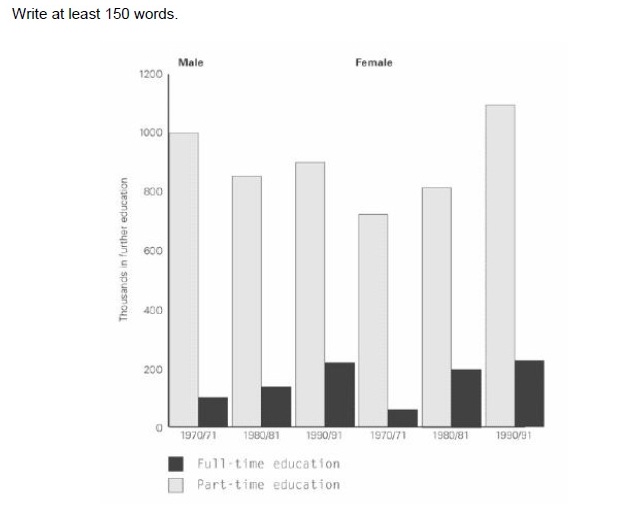The chart below shows the number of men and women in further education in Britain in three periods and whether they were studying full-time or part-time.
The bar chart shows the total number of male and female who take full-time or part time study in higher education in Britain from 1970 to 1990.
In general, it can be seen from the chart that part time education is the highest number which is chosen by most of student male and female. In contrast, full time education is the lowest number between male and female but it is slightly increase in three periods.
The number of men who take part-time study in 1970 was 1000 thousands. Then, ten years later, it dropped steadily to 850 thousands and went up slowly to 900 thousand in 1990. Turn into the women, the number of student female who take part-time education stood at 700 thousand in 1970 and over the two decades, it rose swiftly by 400 thousand and reached a peak at 1100 thousands.
Conversely, the students who take full-time education in three periods were not many. The number of male in full-time education was 100 thousands and it increased gradually over twenty years to 200 thousands. Next, the lowest number of female in full-time education at approximately 50 thousands but between 1980 and 1990 it grew quickly in around 200 thousands.
The bar chart shows the total number of male and female who take full-time or part time study in higher education in Britain from 1970 to 1990.
In general, it can be seen from the chart that part time education is the highest number which is chosen by most of student male and female. In contrast, full time education is the lowest number between male and female but it is slightly increase in three periods.
The number of men who take part-time study in 1970 was 1000 thousands. Then, ten years later, it dropped steadily to 850 thousands and went up slowly to 900 thousand in 1990. Turn into the women, the number of student female who take part-time education stood at 700 thousand in 1970 and over the two decades, it rose swiftly by 400 thousand and reached a peak at 1100 thousands.
Conversely, the students who take full-time education in three periods were not many. The number of male in full-time education was 100 thousands and it increased gradually over twenty years to 200 thousands. Next, the lowest number of female in full-time education at approximately 50 thousands but between 1980 and 1990 it grew quickly in around 200 thousands.

Untitled.jpg
